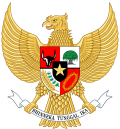Third Development Cabinet Kabinet Pembangunan III | |
|---|---|
| 30th Cabinet of Indonesia | |
| 1978–1983 | |
 | |
| Date formed | 31 March 1978 |
| Date dissolved | 16 March 1983 |
| People and organisations | |
| Head of government | Suharto |
| No. of ministers | 24 ministers |
| Member parties | |
| Status in legislature | Coalition |
| History | |
| Predecessor | Development II Cabinet |
| Successor | Development IV Cabinet |
| ||
|---|---|---|
Pre-presidency Domestic policy Foreign policy Post-presidency Family
| ||
| Gallery: Picture, Sound, Video | ||
The Third Development Cabinet (Indonesian : Kabinet Pembangunan III) is the name of the cabinet of the Indonesian government led by President Suharto and Vice President Adam Malik. The cabinet was announced on 29 March 1978 and served from 31 March 1978 until 16 March 1983.
Contents
- Cabinet leaders
- Cabinet members
- Coordinating ministers
- Departmental ministers
- State ministers
- Junior ministers
- Officials with ministerial status
- Changes
- References
- Notes
The Sapta Krida (tasks) of the Third Development Cabinet are as follows:
- The establishment of an environment and a situation which will ensure social justice for the people through the equity of Development and its results.
- The accomplishment of a high economic growth.
- The consolidation of an ever stronger national stability.
- The creation of a clean and legitimate state apparatus.
- The continuing development of a stronger national unity and oneness with the Guide to Learn and Apply Pancasila (P4) as its foundation.
- The holding of a direct, universal, free, and secret legislative election with the aim of strengthening Pancasila democracy.
- Further developing a free and active foreign policy for the sake of national interest and with the aim of strengthening national resilience.





